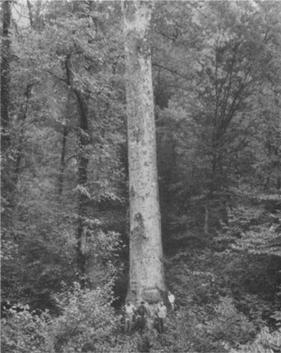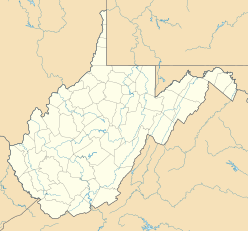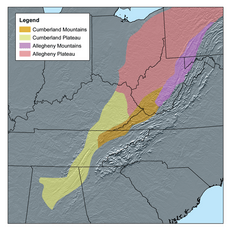Webster Sycamore facts for kids
Quick facts for kids Webster Sycamore |
|
|---|---|

A photograph of the Webster Sycamore published in Castanea (1955) with four men standing at the base of its trunk, demonstrating the scale of the large tree
|
|
| Species | American sycamore (Platanus occidentalis) |
| Coordinates | 38°31′04.2″N 80°21′23.6″W / 38.517833°N 80.356556°W |
| Date seeded | before 1508 AD |
| Date felled | 2010 |
| Custodian | Purdee and Curtin Lumber Company |
The Webster Sycamore was a giant American sycamore tree in West Virginia. People also called it the Webster Springs Sycamore or the Big Sycamore Tree. For a long time, it was the biggest living American sycamore in West Virginia. The tree stood about 4.5 miles (7.2 km) east of Webster Springs. It grew in a wet, flat area next to the Back Fork Elk River. This river is a smaller stream that flows into the Elk River.
The Webster Sycamore was very tall, reaching 112 feet (34 m) high. Its branches spread out 90 feet (27 m) wide. The trunk measured 25.75 feet (7.85 m) around at chest height. In 1955, a group called the American Forests Association said it was the biggest sycamore in the whole United States. But it only held this title for three weeks! They soon found an even bigger sycamore in Maryland. Even so, the Webster Sycamore remained the largest American sycamore in West Virginia. Later, in 1963, a survey found it was the second-largest tree in West Virginia. A huge white oak in Randolph County was bigger.
The land where the Webster Sycamore grew belonged to the Pardee and Curtin Lumber Company. They chose not to cut down the tree during their logging work in the 1950s. A scientist from West Virginia University said the tree was like "a memorial of the original virgin forest." The company even made the area around the tree into a park called Big Sycamore Park. People could visit the tree during special events like Webster Wildwater Weekend and Webster County Nature Weekend. They would go on hikes to see it.
Sadly, on September 3, 2007, someone started a fire on purpose inside the base of the tree's trunk. The tree survived the fire, but it was badly hurt. The West Virginia Division of Forestry checked the tree and decided it was too dangerous to leave standing. They said it was an "extreme hazard." In January 2008, a 17-year-old was charged with setting the fire. After the fire, experts suggested the tree should be cut down or fenced off for safety. The Division of Forestry said the tree was finally brought down in the summer of 2010. When it was cut down, the Webster Sycamore was thought to be over 500 years old.
Contents
Where the Webster Sycamore Grew
Long ago, before European settlers came, the Allegheny Mountain Range was covered in very old forests. These forests had many large deciduous hardwood trees. The American sycamore was one of these trees. American sycamores can grow at least 100 feet (30 m) tall. They grow all over the Eastern United States.
Sycamores like wet soil, especially along rivers and streams. They are common in low-lying areas near water. You can find American sycamores in every county in West Virginia. They are most common along the state's streams.
The Webster Sycamore was once West Virginia's largest American sycamore. It grew in a wet, flat area next to the Back Fork Elk River. This river is a smaller stream that flows into the Elk River. The tree was in Webster County. It was about 4.5 miles (7.2 km) east of Webster Springs.
How Big and Old Was It?
Measurements and Age
People measured the Webster Sycamore many times over the years. The measurements of its trunk size were a bit different each time. In 1955, the tree's trunk was 24 feet 8 inches (7.52 m) around at chest height. This was measured 4.5 feet (1.4 m) from the ground. Higher up, at 45 feet (14 m) from the ground, its trunk was 4.33 feet (1.32 m) across. The main trunk reached 82 feet (25 m) high. A past windstorm had broken off its top. The tree's branches spread out about 75 feet (23 m) wide. The lowest branch was 23.5 feet (7.2 m) from the ground. This branch was 2 feet (0.61 m) wide.
However, in 1963, official measurements showed the tree's trunk was more than 7 feet (2.1 m) across at chest height. Its circumference was 23 feet (7.0 m). The sycamore was thought to be at least 120 feet (37 m) tall. Its trunk was about 5 feet (1.5 m) across when measured 90 feet (27 m) from the ground.
In 2002 and 2011, the Webster Sycamore was still called the largest American sycamore in West Virginia. At that time, it was 112 feet (34 m) tall. Its crown spread 90 feet (27 m) wide. Its trunk was 25.75 feet (7.85 m) around at chest height.
By the time it was cut down in 2010, the Webster Sycamore was believed to be over 500 years old.
Other Features of the Tree
In 1955, a small eastern hemlock tree was growing from a rotten hole in the sycamore's main south branch. This hemlock was 5.5 feet (1.7 m) tall. By 1963, the hemlock was still there. One writer even compared this to a famous Greek story about piling mountains on top of each other. At that time, the sycamore had no other holes or marks on its outside. But by 2007, the tree's trunk had a big opening at its base. This opening led into its hollow center. Visitors could even step inside the tree!
How the Tree Was Recognized
The Webster Sycamore had been a famous local landmark for a long time. People knew it because it was so old and big. Many locals even thought it was the biggest American sycamore in the world. As early as 1920, a book called Trees, Stars and Birds: A Book of Outdoor Science included a picture and description of a large sycamore near Webster Springs. This was probably the Webster Sycamore.
In 1955, the tree became famous when the American Forests Association named it the largest of its kind in the United States. But as mentioned, it only held this title for three weeks. A bigger sycamore was found in Maryland. Even so, the Webster Sycamore stayed the largest American sycamore in West Virginia.
In 1963, during a "big-tree contest" for West Virginia's 100th birthday, the state's largest tree title went to a white oak. This oak grew near Huttonsville in Randolph County. It was 11.25 feet (3.43 m) across, beating the Webster Sycamore. An elm tree in Putnam County also beat the sycamore, measuring 8 feet (2.4 m) across.
On June 20, 2004, U.S. Senator Robert C. Byrd gave a speech in the United States Senate. He talked about West Virginia Day and mentioned the Webster Sycamore. He was proud of "the biggest and best of West Virginia."
Protecting the Giant Tree
The land where the Webster Sycamore stood belonged to the Purdee and Curtin Lumber Company. This company was from nearby Webster Springs. In the 1950s, when they were cutting down trees in the area, they decided to save the sycamore. A biologist from West Virginia University said the tree was like "a memorial of the original virgin forest." The lumber company even turned the land around the tree into a park. It was called Big Sycamore Park. Campers and tourists used the park and visited the tree. A swinging bridge over the Back Fork of Elk River helped people get to the tree and the park.
In 2002, the West Virginia Humanities Council nominated the Webster Sycamore to a special list. This list was called the National Register of Historic Trees. It keeps track of important trees.
Every year, during the Webster Wildwater Weekend in April and the Webster County Nature Weekend in May, people went on hikes to see the Webster Sycamore. They also visited the nearby Three Falls of Back Fork.
See also
- Largest organisms
- List of individual trees




